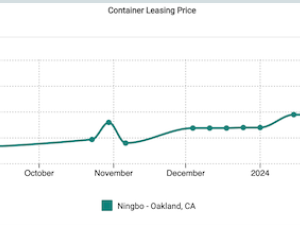(Editor's note: Following is an edited version of remarks by Albert A. Pierce, Executive Director Westbound Transpacific Stabilization Agreement (WTSA) before the Agriculture Ocean Transportation Coalition (AgOTC) Annual Meeting San Francisco, CA ' June 10, 2005.)
Any assessment of the westbound, US to Asia freight market in 2005 ' let alone any attempt at forecasting ' is problematic. The trade, in and of itself, has been relatively stable, and growing. A weaker dollar has helped the high end of the market, particularly specialty agricultural commodities. Industrial growth and new construction throughout China and Southeast Asia have led to heightened demand for low-end products such as wastepaper, metal and plastic scrap, resins and industrial clay, and mid-range commodities such as cotton and forest products, especially building materials. The market grew 11.5% in 2003, slowing to 4.5% growth last year but still posting a record 1.9 million 40-foot containerloads. This year we anticipate growth in the 6-7% range.
Freight rates are improving gradually from the basement levels of two years ago. Despite a nearly 2.7-to-1 cargo and equipment imbalance in the Pacific and vessels chronically sailing with half loaded and half empty containers, shipping lines have been able to make the case for more compensatory rates in the interest of maintaining service levels and equipment availability. In the dry cargo segment, the increases have ranged from $50 to $200 per FEU, targeted by commodity. These actions have generally been accepted by shippers. In the reefer segment, we've adopted minimum rates intended to recover rising service costs and keep both standard reefer and temperature-controlled equipment in the market, despite the beef and poultry embargoes now entering their third year.
Beef and poultry remain a big question mark in terms of the largest markets ' Japan, Korea and the PRC. Losing this business over a sustained period of time has hurt carriers as well as the exporters themselves, and it will take time and perseverance to regain market share from third country suppliers. The recent market opening by Taiwan will hopefully offer a model for the other countries to move forward, but the inspection issue remains to be resolved, so we just don't know whether we will see meaningful progress in 2005. Pork exports are up sharply throughout Asia, though not enough to fill the beef and poultry gap.
Cotton is showing huge potential, mainly in China but also in Indonesia, Vietnam and Cambodia. Again, we can't be certain whether and to what extent the US might actually apply safeguard limitation quotas against Chinese textiles and apparel, and there will likely be some erosion of market share from competitive foreign sourcing, but generally the outlook appears positive.
Other agricultural export products expected to do well this year include dairy products such as dry nonfat milk' softwood lumber and wood products for construction' and tree fruits and nuts. Taiwan's decision to end its four-month ban on phytosanitary certificates for apples will undoubtedly help the overall numbers even further.
The US Department of Agriculture forecasts an increase in US farm exports from $56 billion last year to $59 billion in 2005. Much of that new growth, however, is forecast to come from export sales to Mexico and Canada. Notably, USDA predicts that 2005 is the year Mexico will surpass Japan for the first time as a buyer of US agricultural products. Still, we expect modest but steady trade and cargo growth throughout the year. The real challenges for carriers and shippers in the US-Asia market, unfortunately, grow out of trends in the reverse direction ' the inbound trade from Asia to the US.
We are in the midst of a two to three-year throughput capacity crisis in the Pacific and, unlike in past years, we will not be able this time to grow our way out of the problem solely with more and





